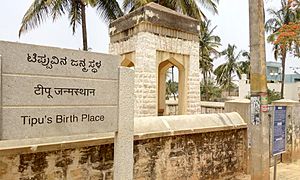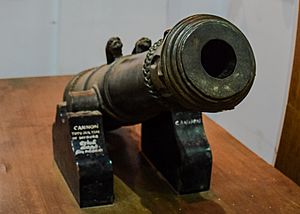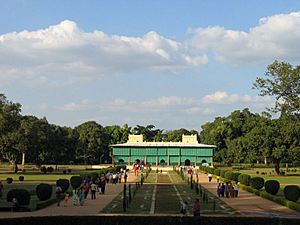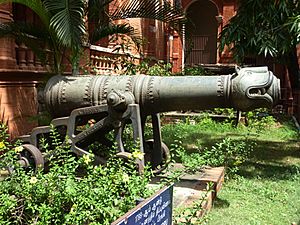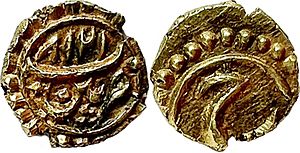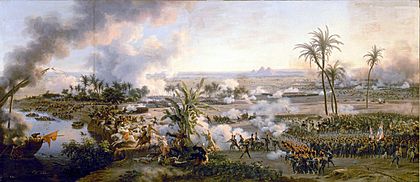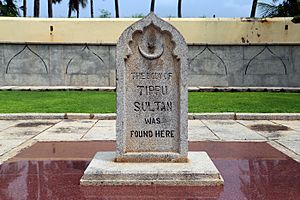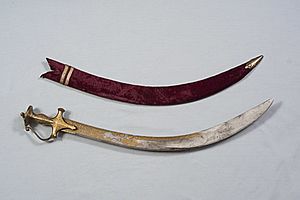Tipu Sultan facts for kids
Quick facts for kids Tipu Sultan |
|||||
|---|---|---|---|---|---|
| Badshah Nasib-ud-Daulah Mir Fateh Ali Bahadur Tipu |
|||||
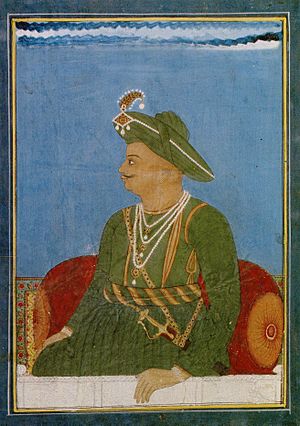
Portrait of Tipu Sultan by an anonymous Indian artist in Mysore, c. 1790–1800
|
|||||
| Sultan of Mysore | |||||
| Reign | 10 December 1782 – 4 May 1799 | ||||
| Coronation | 29 December 1782 | ||||
| Predecessor | Hyder Ali | ||||
| Successor | Krishnaraja III (as Maharaja of Mysore) |
||||
| Born | Sultan Fateh Ali Sahab Tipu 1 December 1751 Devanahalli, Sultanate of Mysore (modern-day Karnataka, India) |
||||
| Died | 4 May 1799 (aged 47) Srirangapatna, Sultanate of Mysore (modern-day Karnataka, India) |
||||
| Burial | Srirangapatna, present-day Mandya, Karnataka 12°24′36″N 76°42′50″E / 12.41000°N 76.71389°E |
||||
| Spouse | Khadija Zaman Begum and 2 or 3 others | ||||
| Issue | Shezada Hyder Ali, Ghulam Muhammad Sultan Sahib and many others | ||||
|
|||||
| House | Mysore | ||||
| Father | Hyder Ali | ||||
| Mother | Fatima Fakhr-un-Nisa | ||||
| Religion | Sunni Islam | ||||
| Seal |  |
||||
Tipu Sultan (born Sultan Fateh Ali Sahab Tipu; 1 December 1751 – 4 May 1799) was a powerful ruler of the Kingdom of Mysore in South India. He was also known as the Tiger of Mysore. Tipu Sultan was a pioneer in using rocket artillery in warfare.
During his rule, he brought in many new ideas. He created a new system for money and a new calendar. He also started a new way to collect land taxes. This helped the Mysore silk industry grow a lot. He made the iron-cased Mysorean rockets even better. He also wrote a military guide called Fathul Mujahidin. He used these rockets against the British and their allies in wars. These included the Battle of Pollilur and the Siege of Srirangapatna.
Tipu Sultan and his father, Hyder Ali, worked with the French army. They fought against the British and other nearby kingdoms. These included the Marathas, Malabar, and Travancore. Tipu became the ruler of Mysore in 1782 after his father passed away. He won important battles against the British in the Second Anglo-Mysore War. He then signed the Treaty of Mangalore in 1784, which ended that war.
Tipu Sultan was a strong enemy of the British East India Company. He attacked British-allied Travancore in 1789. This started the Third Anglo-Mysore War. In this war, he lost many lands, including Malabar. He sent messengers to other countries like the Ottoman Empire and France. He hoped to get their help against the British.
In the Fourth Anglo-Mysore War, the British, Marathas, and the Nizam of Hyderabad joined forces. They defeated Tipu Sultan. He was killed on 4 May 1799 while defending his fort at Srirangapatna.
Contents
Early Life
Growing Up
Tipu Sultan was born on 10 November 1751 in Devanahalli. This place is now in Karnataka, India. He was named after a saint called Tipu Mastan Aulia. His father, Hyder Ali, made sure Tipu got a good education. He also involved Tipu in military and political matters from a young age. By age 17, Tipu was leading important missions. He became his father's main helper in wars.
Hyder Ali was a military officer who became the ruler of Mysore in 1761. Tipu's mother was Fatima Fakhr-un-Nisa. Tipu learned many subjects, including Urdu, Persian, Arabic, and Kannada. He also learned about the Quran, Islamic law, riding, shooting, and fencing.
Language Skills
Tipu Sultan's first language was Urdu. French visitors noted that he also spoke Persian.
Early Military Actions

First Battles
French officers taught Tipu Sultan military tactics. At 15, he fought with his father against the British in the First Mysore War in 1766. At 16, he led cavalry in the invasion of Carnatic. He also showed great skill in the First Anglo-Maratha War from 1775 to 1779.
Alexander Beatson, a historian, described Tipu Sultan. He said Tipu was about five feet eight inches tall. He had a short neck, broad shoulders, and was a bit heavy. His hands and feet were small. He had large eyes, arched eyebrows, and a hooked nose. His skin was fair, and he looked dignified.
Second Anglo-Mysore War
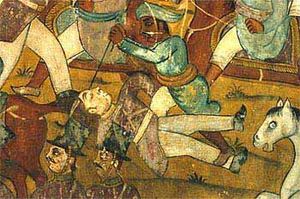
In 1779, the British captured Mahé, a French port that Tipu protected. In response, Hyder Ali invaded Carnatic to push the British out of Madras. In September 1780, Tipu Sultan led 10,000 men and 18 guns. He stopped Colonel Baillie, who was trying to join another British force. In the Battle of Pollilur, Tipu won a major victory. Many European and Indian soldiers were captured or killed.
Tipu Sultan also defeated Colonel Braithwaite in February 1782. Braithwaite's force was captured, and all their guns were seized. By December 1781, Tipu had taken Chittur from the British. Tipu Sultan had gained much military experience when his father, Hyder Ali, died on 6 December 1782. Tipu realized the British were a new kind of threat. He became the ruler of Mysore on 22 December 1782. His coronation was simple.
He then tried to stop the British by making friends with the Marathas and the Mughals. The Second Mysore War ended with the Treaty of Mangalore in 1784.
Ruler of Mysore
In 1780, Tipu declared himself Badshah (Emperor) of Mysore. He also started making his own coins.
Conflicts with the Maratha Empire
The Maratha Empire had become very strong. They had defeated Tipu's father twice. Hyder Ali had to accept the Marathas as the main power. Tipu Sultan wanted to break free from these agreements. He tried to take back some forts that the Marathas had captured. He also stopped paying the tribute his father had promised. This led to the Maratha–Mysore War.
Some battles between Mysore and the Marathas included:
- Siege of Nargund (1785) – Mysore won.
- Siege of Badami (1786) – Mysore surrendered.
- Siege of Adoni (1786) – Mysore won.
- Battle of Gajendragad (1786) – Marathas won.
The war ended with the Treaty of Gajendragad in March 1787. Tipu had to return all land his father had taken from the Marathas. He also agreed to pay a large sum of money. In return, he got to keep some areas he had captured during the war. In the Fourth Anglo-Mysore War, the Maratha Empire supported the East India Company.
Invasion of Malabar (1766–1790)
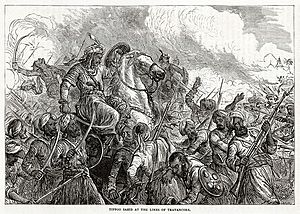
In 1766, Tipu Sultan, at just 15, joined his father in invading Malabar. Later, Tipu came back to Malabar to regain control. After the Battle of the Nedumkotta (1789–90), he had to go back to Mysore. This was because of monsoon floods, strong resistance from Travancore, and news of a British attack on Srirangapatnam.
Third Anglo-Mysore War
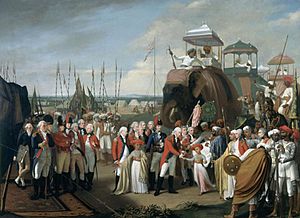
In 1789, Tipu Sultan disagreed with Travancore buying two Dutch forts. On 28 December, he attacked Travancore. He knew Travancore was an ally of the British East India Company. The Travancore army fought back strongly. The ruler of Travancore asked the East India Company for help. Lord Cornwallis gathered British forces. He also made alliances with the Marathas and the Nizam of Hyderabad against Tipu.
In 1790, the British took control of much of the Coimbatore area. Tipu fought back and regained most of the land. He then moved into Carnatic. He tried to get the French to join the fight, but he failed.
In 1791, Tipu's enemies advanced. The main British force took Bangalore and threatened Srirangapatna. Tipu used a "scorched earth" tactic, destroying resources to deny them to the British. This worked, and the British had to retreat to Bangalore. Tipu then retook Coimbatore after a long siege.
The 1792 campaign was a failure for Tipu. The allied army was well-supplied. Tipu could not stop them from joining forces before Srirangapatna. After about two weeks of siege, Tipu started talking about surrender. In the Treaty of Seringapatam, he had to give up half his lands to the allies. He also had to send two of his sons as hostages until he paid a large war fine. He paid the amount and got his sons back.
Napoleon's Plans
In 1794, Tipu supported the Jacobin Club of Mysore. He planted a Liberty Tree and called himself Citizen Tipoo. Some historians believe the British East India Company made up this story to justify fighting Tipu.
Napoleon invaded Egypt to try and connect with India. He wanted to join forces with Tipu Sultan against the British. Napoleon believed that once he conquered Egypt, he could send troops to India. This plan failed when Napoleon lost battles in 1799 and 1801.
Death
Fourth Anglo-Mysore War
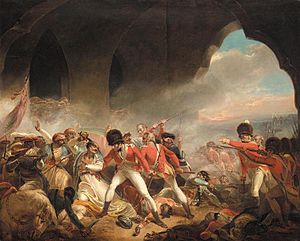
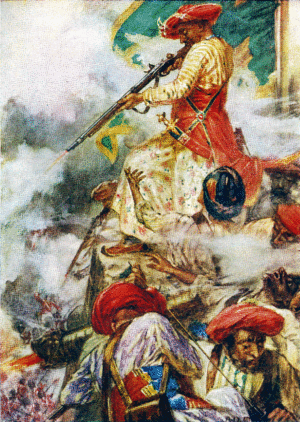
In 1799, three armies marched into Mysore. They were from Bombay and two British forces, one led by Arthur Wellesley. They surrounded Tipu's capital, Srirangapatna, in the Fourth Mysore War. The British East India Company had over 60,000 soldiers. Tipu Sultan had only 30,000. Some of Tipu's ministers betrayed him. They worked with the British and weakened the fort walls.
When the British broke through the city walls, French advisors told Tipu to escape. They suggested he fight from other forts. But he refused. Tipu Sultan was killed on 4 May 1799 at the Hoally Gateway. He was buried the next day next to his father. After his death, there were big celebrations in Britain.
Administration
Tipu introduced a new calendar and new money. He also created seven new government departments. He made important military improvements, especially in using rockets.

Mysorean Rockets
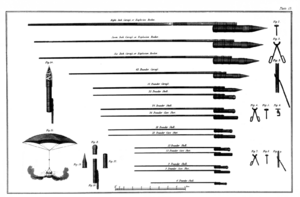
Dr. APJ Abdul Kalam, a former Indian President, called Tipu Sultan the inventor of the world's first war rocket. Two of these rockets, captured by the British, are in a museum in London. Historians say Tipu Sultan was a fierce warrior. He was so fast that enemies thought he was fighting everywhere at once. He was also one of the few Indian rulers to defeat British armies.
Tipu's father had already started using rockets. Tipu improved them further. He had 1,200 special troops to use rocket launchers. These men were skilled in aiming and firing rockets. The rockets had sharp blades on them. When fired together, they caused great damage to large armies. Tipu increased the number of rocket users to 5,000. His rockets were more advanced than what the British had seen. They used iron tubes for propellant, allowing for more power and longer range (up to 2 km).
British records describe rockets used in the third and fourth wars. During the final battle at Srirangapatna in 1799, British shells hit a rocket storage area. This caused a huge explosion. After Tipu's defeat, the British captured many Mysorean rockets. These rockets helped the British develop their own Congreve rocket. These were later used in the Napoleonic Wars.
In 1786, Tipu Sultan decided to build a navy. It would have 20 battleships and 20 frigates. He built large shipyards at Jamalabad and Majidabad. His navy board had 11 commanders. Tipu ordered ships to have copper bottoms. This idea came from Admiral Suffren and made ships last longer.
Army Changes
Because of constant wars, Hyder and Tipu needed a strong, disciplined army. They hired Rajputs, Muslims, and Bedars for full-time service. This replaced the local militia.
Economy
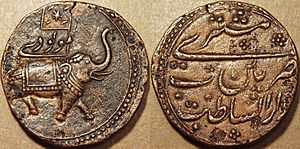
Mysore's economy was strongest under Tipu Sultan in the late 1700s. He and his father worked to make Mysore richer. Mysore became India's leading economic power. It had very good agriculture and textile manufacturing. People in Mysore earned five times more than what was needed for basic living.
Tipu Sultan started the plan for the Kannambadi dam on the Kaveri river. This dam, now called Krishna Raja Sagara, was built later. It provides drinking water for Mysore and Bangalore.
The Mysore silk industry began during Tipu Sultan's rule. He sent an expert to Bengal to learn about silk. After that, Mysore started making its own silk.
Road Building
Tipu Sultan was a pioneer in building roads, especially in Malabar. He connected most cities with roads during his campaigns.
Foreign Relations
Both Hyder Ali and Tipu Sultan had some loyalty to the Mughal Emperor Shah Alam II. However, they did not accept the rule of the Nizam of Hyderabad.
After becoming Badshah, Tipu Sultan sought recognition from the Mughal emperor. He got the title "Nasib-ud-Daula". But the Nizam of Hyderabad was against this. Tipu Sultan then started making friends with other Muslim rulers.
Tipu Sultan managed his own foreign policy. He wanted to remove the East India Company from India. He also wanted to make France strong internationally.
After the Fall of Seringapatam in 1799, the blind emperor felt sad for Tipu. But he trusted the Nizam of Hyderabad, who had made peace with the British.
Tipu Sultan faced threats from the Marathas. He wrote to Zaman Shah Durrani, the ruler of Afghanistan. He hoped they could defeat the British and Marathas together. Zaman Shah first agreed, but a war in Persia stopped him from sending help.
In 1787, Tipu Sultan sent messengers to the Ottoman capital, Constantinople. He asked the Ottoman Sultan Abdul Hamid I for urgent help against the British. He wanted troops and military experts. He also asked to help maintain Islamic holy sites.
However, the Ottomans were busy with their own wars. They needed British help against the Russians. So, they could not risk being enemies with the British in India. Tipu Sultan's messengers returned with only gifts. But Tipu Sultan kept writing to the Ottoman Sultan Selim III until his last battle in 1799.
Like his father, Tipu Sultan had good relations with Mohammad Ali Khan of Persia. He also wrote to Hamad bin Said, the ruler of Oman.
Relations with China Tipu's interest in silk began in the 1780s. An ambassador from China gave him a silk cloth. Tipu was so impressed that he wanted to produce silk in his kingdom. He sent a journey to China, which returned after twelve years.
Both Hyder Ali and Tipu wanted to be allies with the French. The French were the only European power strong enough to challenge the British in India. In 1782, the French made an alliance with the Peshwa Madhu Rao Narayan. This allowed French troops to move to Mauritius. French Admiral De Suffren gave a portrait of Louis XVI to Hyder Ali and asked for his alliance.
Napoleon conquered Egypt to try and connect with Tipu Sultan. In February 1798, Napoleon wrote a letter to Tipu Sultan. He praised Tipu for fighting the British. But a British spy in Muscat seized this letter, and it never reached Tipu. The idea of a Tipu-Napoleon alliance worried the British Governor, Lord Wellesley. He immediately started preparing for a final battle against Tipu Sultan.
Social System
Justice System
Tipu Sultan appointed judges for both Hindu and Muslim people. There were Qadi for Muslims and Pandit for Hindus in each area. Higher courts also had similar systems.
Religious Policy
Tipu was a devout Muslim. He prayed daily and cared for mosques. He also gave money to about 156 Hindu temples. These included the famous Ranganathaswami Temple at Srirangapatna. Many sources say he had Hindu officers in his government. He also gave land and gifts to Hindu temples. This shows his religious tolerance.
However, his religious legacy is debated in India. Some groups see him as a great warrior for his faith. Other sources describe conflicts with some Hindu and Christian groups. They also mention the destruction of some churches and temples.
Relations with Hindus
Tipu Sultan's treasurer was Krishna Rao. Shamaiya Iyengar was his Minister of Post and Police. Purnaiya held the important post of "Mir Asaf". Many of his chief agents and officers were Hindu.
Records show that Tipu Sultan's court corresponded with temples. He donated jewelry and land to several temples. Between 1782 and 1799, Tipu Sultan issued 34 "Sanads" (deeds) for temples. He also gave them silver and gold items.
The Srikanteswara Temple in Nanjangud still has a jeweled cup from the Sultan. He also gave a greenish linga to the Ranganatha temple. This temple was very close to his palace. He would listen to both temple bells and the Muslim call to prayer. He also gave silver items to the Lakshmikanta Temple at Kalale.
During the Maratha–Mysore War in 1791, Maratha horsemen attacked the Sringeri Shankaracharya temple. They hurt and killed many people and stole valuables. The Shankaracharya asked Tipu Sultan for help. About 30 letters between Tipu Sultan's court and the Sringeri Shankaracharya were found in 1916.
Tipu Sultan immediately ordered help for the Swami. He sent money and gifts. His interest in the Sringeri temple continued for many years. Historians describe Tipu Sultan as a defender of the Hindu dharma. He also supported other temples. He did take back some unauthorized land grants given to Brahmins and temples. But he did not take back those with proper certificates. This was a normal practice for any ruler.
The Coinage System
Tipu introduced new coin names and types. He used new Persian names for gold and silver coins. For copper coins, he used names like Qutb (pole star) and Zohra (Venus). For silver, he used names like Imami (referring to the 12 Shi'ite Imams). For gold, he used names like Faruqi and Ahmadi.
Coinage Dating System
Tipu Sultan changed the dating system on his coins. He stopped using the Hijri system. He started using the Mauludi system. This system was based on the solar year and the birth year of Muhammad. He also added the name of the Indian cyclic year on large silver and gold coins.
Assessment and Legacy
People have strong and different opinions about Tipu Sultan. Indian governments have often celebrated his memory. But some political parties have been critical. School textbooks in India recognize him as a "freedom-fighter." The original copy of the Constitution of India has a painting of Tipu Sultan.
India's 14th President, Ram Nath Kovind, praised Tipu Sultan. He said Tipu Sultan died fighting the British. He also noted Tipu was a pioneer in developing war rockets.
Tipu Sultan is also seen as a hero in Pakistan. Former Pakistani Prime Minister Imran Khan admired him as a freedom fighter. Tipu also supported art forms like Ganjifa cards, saving this art.
Sword and Tiger
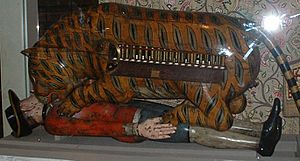
Tipu Sultan lost his sword in a war with the Nairs of Travancore. This was during the Battle of the Nedumkotta (1789). He had to retreat due to attacks from the Travancore and British armies. The ruler of Travancore gave the sword to the Nawab of Arcot. The British later took it as a war trophy and sent it to London. It was displayed in the Wallace Collection.
Tipu was known as the Tiger of Mysore. He used the tiger as his symbol. It is said that he once killed a tiger with his dagger when his gun failed. This earned him the name. He even had French engineers build a mechanical tiger for his palace. This device, called Tipu's Tiger, is in the Victoria and Albert Museum in London. Tipu used the tiger emblem on his banners, weapons, and around his palace.
The last sword Tipu used in his final battle was taken by the British. His ring was also taken. In 2004, Vijay Mallya bought Tipu Sultan's sword at an auction in London. He brought it back to India. In 2013, another sword owned by Tipu Sultan was auctioned and sold.
Tipu Sultan Jayanti
In 2015, the Government of Karnataka started celebrating Tipu's birthday. It was called "Tipu Sultan Jayanti" and was an annual event on 20 November. However, in 2019, the next Chief Minister ordered the celebrations to be cancelled.
In Stories
Tipu Sultan appears in many books and TV shows.
- He is in G. A. Henty's 1896 book The Tiger of Mysore.
- In Jules Verne's Mysterious Island, Captain Nemo is Tipu's nephew.
- He was played by Paidi Jairaj in the 1959 Indian film Tipu Sultan.
- The 1988 Indian TV series Bharat Ek Khoj had an episode about him.
- The Sword of Tipu Sultan was a popular TV series based on a novel.
- The Dreams of Tipu Sultan is a 1997 play by Girish Karnad.
- He appears as a "Great Person" in the video games Sid Meier's Civilization: Revolution and Sid Meier's Civilization IV.
- In the novel Sharpe's Tiger, the character Richard Sharpe fights at Seringapatam and kills Tipu.
Family
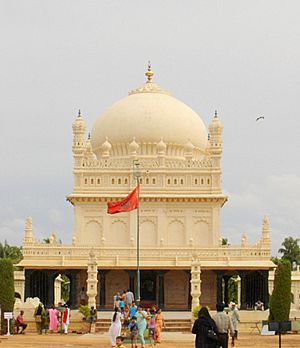
Tipu Sultan's family claimed to be descendants of Muhammad. Tipu had several wives. One, Sindh Sahiba, was known for her beauty and intelligence. Tipu's family was sent to Calcutta by the British. Many of his descendants still live in Kolkata.
His sons included:
- Shahzada Sayyid Shareef Hyder Ali Khan Sultan (1771 – 1815)
- Shahzada Sayyid walShareef Abdul Khaliq Khan Sultan (1782 – 1806)
- Shahzada Sayyid walShareef Muhammad Yasin Khan Sultan (1784 – 1849)
- Shahzada Sir Sayyid walShareef Ghulam Muhammad Sultan Sahib, KCSI (1795 – 1872)
Images for kids
-
A flintlock blunderbuss, made for Tippu Sultan in Srirangapatnam in 1793-94. Tippu Sultan used many Western craftsmen, and this gun reflects the most up-to-date technologies of the time.
See also
 In Spanish: Sultán Fateh Ali Tipu para niños
In Spanish: Sultán Fateh Ali Tipu para niños
- Muslim warriors
- Mysore invasion of Kerala
- PNS Tippu Sultan
- Tipu Sultan Mosque
- Tipu's Tiger
- The Dreams of Tipu Sultan by Girish Karnad
- Mir Ghulam Ali, an official and senior military commander


